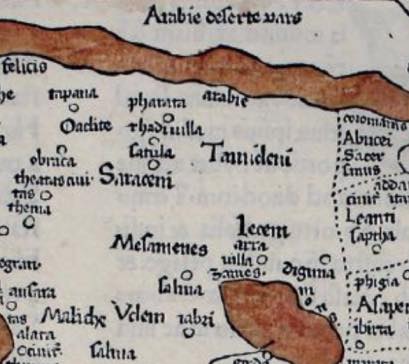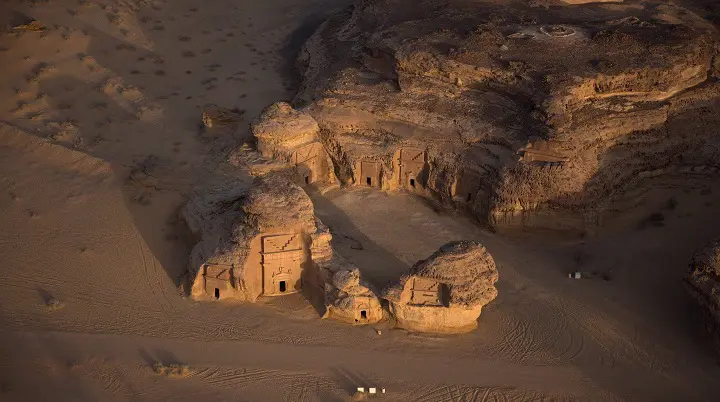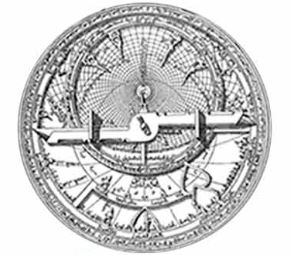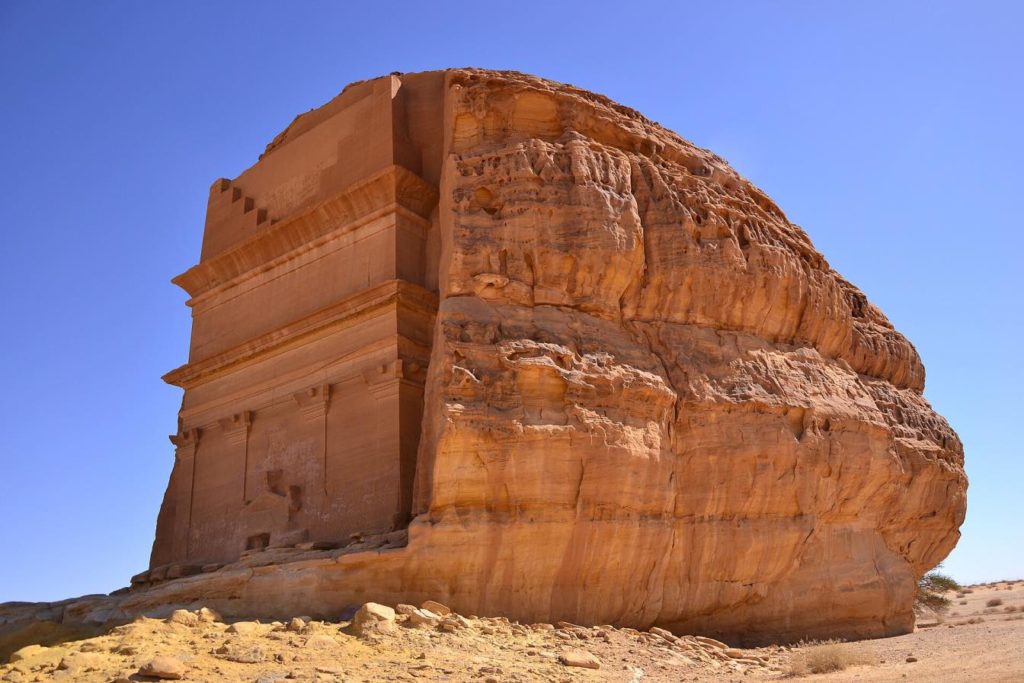
The Qur’ān mentions the tribe of Thamūd more than fifteen times, either explicitly mentioning them as Thamūd or as the ‘people of Ṣāliḥ’. The name ‘Ṣāliḥ’ is historically non-existent and was invented by Muḥammad. It is not mentioned by any other Hebrew, Greek or Roman historical sources nor has anyone come across it in any manuscript or archaeological excavation. Who, then, are these ‘Thamūd’?
THE HISTORY OF ‘Thamūd’ dates back to the third millennium BC (circa 3000–2500 BC), and they were inhabitants of north-western Arabia, near the present-day Jordan. They were engaged in trade and guarded the main trade route between Yemen and the Levant. They had their own written language, which resembled written cuneiform. Researchers have found evidence of this Thamūdic language in the Hijaz, in Yemen and Najd. The geographical spread of their language indicates their trading activity and their transiting between Najd, Yemen and the north of the Arabian peninsula.[1] Ptolemy mentions them in his book on geography[2] and Diodorus referred to them similarly.[3] Their region was considered to be an extension of Nabataean lands.
After the Roman occupation of Petra and the northwest of the Arabian peninsula during the reign of Emperor Trajan (second century AD), the Thamūdites served as soldiers in the Roman army.[4] Their existence is attested up until the fifth century AD[5] as inhabiting the Al-Ḥijr region in northwestern Arabia. This area is mostly made up of porous limestone mountains. This type of stone erodes from the inside from water containing carbonic acid, from rain absorbing carbon dioxide from the atmosphere. When this water seeps into the mountain through cracks in the rock, the rock erodes from the inside and numerous caves are formed which may extend tens of meters inside the mountain.
Muḥammad imagined that these caves were the homes of the Thamūd
For this reason caves are abundant in this region of Arabia and in Palestine. The Old Testament writers mention that David composed Psalms 57 and 142 in the cave where he was hiding when he fled from King Saul. Elijah also disappeared into a cave when confronted by the prophets of the god Baal, and in that cave a revelation came to him (Genesis 17:23 and Samuel 1:22). The Old Testament states that caves were used as burial grounds.
Since Muḥammad was traveling to the Levant in the convoys of Quraysh, the road passed through the cave-rich area of Al-Ḥijr now known as Madā’in Ṣāliḥ. In those mountains there are rows of façades carved into the mountains, and in the middle of each façade there is a square door which is the entrance to the cave. Muḥammad imagined that these caves were the homes of the Thamūd, and in his Qur’ān he addressed Thamūd through their Prophet Ṣāliḥ:
And you hew houses out of the mountains astutely[6]
He also spoke of the people of ‘Ād who inhabited the same area, as the Qur’ān claims, when he said to Thamūd:
And remember when He made you successors after ‘Ād and settled you in the land – you make mansions on its plains and hew out houses in the mountains.[7]
It might be useful to mention that the people of ‘Ād appear nowhere in history nor in the Liḥyan, Nabataean or Thamūdic languages. The tribes of Liḥyān inhabited the Al-Ḥijr region about the sixth to fourth centuries BC and had their own written language. Their capital was Dīdān (Al-Ulā governorate), which is the site of present-day Madā’in Ṣāliḥ.
The authors of the Qur’ān lied with their claim that Thamūd perished
The Liḥyans made no mention of the people of ‘Ād in their inscriptions. Experts have found no inscription or manuscript mentioning the people of ‘Ād. Even the Old Testament writers and the Hebrew manuscripts, which mention large numbers of tribes, do not mention the people of ‘Ād or their prophet Hūd. The Qur’ān is the only source that mentions them. Did Thamūd really succeed the people of ‘Ād while the Thamūdic inscriptions did not mention them? Islamic websites have posted several videos and photos showing massive structures two or three times the size of the average human, claiming that it was the site of the newly discovered ‘Ād tribes. But in reality the skeletons depicted are plastic structures constructed by Hollywood for a science fiction film.
Coming back to the Qur’ān and its statement about the Thamūd: And you hew houses out of the mountains astutely, one asks whether the Thamūd really did carve the mountains in the period BC, given that these are semi-nomadic Arabs without machines to dig a well, let alone carve into mountains. These façades were in fact carved out by the Nabataeans when their kingdom expanded south to include the area where these caves were located.[8] The Nabataeans carved out these façades on the entrances to already existing caves, and may have enlarged some of them to use as burial-places for their royal families.
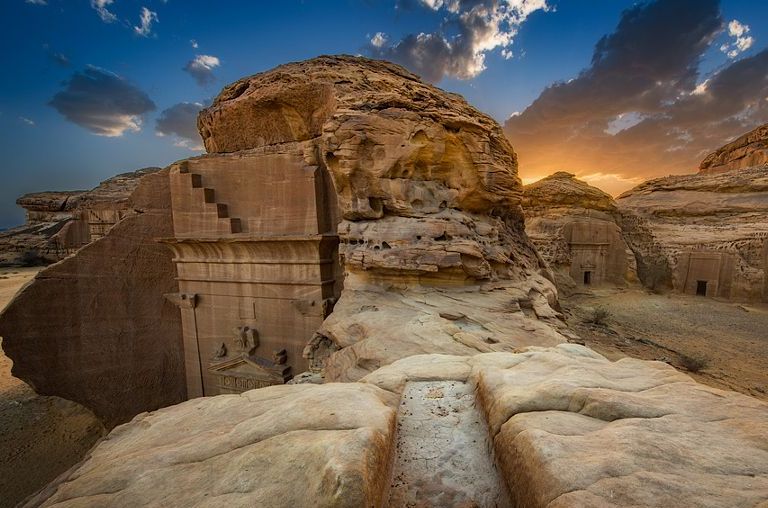
Suggested Reading
The entrances carved into the façade of these caves have Liḥyan, Nabataean and Roman inscriptions, but there are no Thamūdic carvings there, even though the region was the main settlement area of the Thamūdians. This indicates that the Thamūd did not hew houses out of the mountains as the Qur’ān says. An indication that the caves did not serve as homes is that the exterior façades are beautifully carved and have beautiful inscriptions, while inside the visitor will only find miserable caves unsuitable as housing. They do not match the beauty of the entrance because the interior of the cave was a cemetery for the dead kings and nobles.
The Qur’ān says of Thamūd:
Then the tremor overtook them, so they became motionless bodies in their abode.[9]
The tremor in the Qur’ānic concept is the earthquake. But there is no historical record of any earthquake that struck the Al-Ula area in which Madā’in Ṣāliḥ is located, nor have any excavations find any evidence of an earthquake in that area.
It is clear that the authors of the Qur’ān were ignorant of the history of that region
If the Thamūd did carve these caves with their beautiful façades, and then an earthquake came to them that wiped them all out, that earthquake would inevitably have caused cracks and damage to these beautiful façades, even if the caves were not demolished. But there are no cracks in the façades. The authors of the Qur’ān lied with their claim that Thamūd perished with the tremor.[10]
The Qur’ān then goes on to tell us that
And (the tribe of) Thamūd He spared not [11]
Qur’ānic commentators say that the verse means that Allah did not leave anyone from Thamūd alive and eliminated them all. But historical sources confirm that the Thamūd lasted up until the fifth century AD, only about a hundred years before the appearance of Muḥammad.[12] The strange thing is that the Qur’ān itself tells us how
We verily sent unto Thamūd their brother Ṣāliḥ, saying: Worship Allah. And lo! (they then became) two parties quarrelling.[13]
This means that there is a group that believed in Ṣāliḥ who quarreled with non-believers. Did Allah also destroy the believers with an earthquake and therefore say: And (the tribe of) Thamūd He spared not? It is said that one day al-Ḥajjāj ibn Yūsuf al-Thaqafī preached a sermon saying:
“I am informed that you say that the Thaqīf are the remnants of Thamūd. Woe unto you! Did any other than the nobles of Thamūd and those who believed in Ṣāliḥ survive?” Then he went on: “Allah said: And (the tribe of) Thamūd He spared not”. News of this reached al-Ḥasan al-Baṣrī who laughed and said: “That is his own judgement, but the Almighty did say: He spared not, that is, He did not preserve them but destroyed them.” This was reported to al-Ḥajjāj who summoned him. But he lay low and hid from him until al-Ḥajjāj perished”.[14]
It is clear from this narrative that the authors of the Qur’ān were ignorant of the history of that region, and therefore the Qur’ān of theirs conflicted with history as is documented by excavations and manuscripts. The people of ‘Ād did not exist and were not succeeded by Thamūd in the Al-Ḥijr area. Nor did the Thamūd carve houses in the mountains, and nor did Allah destroy the Thamūd by ‘the tremor’.
[1] Jawad Ali, تاريخ العرب قبل الإسلام (‘History of the Arabs before Islam’), vol. 1, p. 315.
[2] Ptolemy, Geography, VI 4:7, 21:7.
[3] Hejaz, pp. 291, Diodorus, Bibl. Hist. III. 44.
[4] Jawad Ali, p. 317
[5] ibid., p. 1
[6] Qur’ān XXVCI (al-Shu‘arā), 149.
[7] Qur’ān VII (al-A‘rāf), 74.
[8] The New Encyclopædia Britannica: Macropædia Volume 13). USA: Encyclopædia Britannica, Inc. 1995. p. 818.
[9] Qur’ān VII (al-A‘rāf), 78.
[10] Dan Gibson (2011). Qur’ānic Geography: A Survey and Evaluation of the Geographical References in the Qur’ān with Suggested Solutions for Various Problems and Issues. (See this book in the Almuslh Library here).
[11] Qur’ān LIII (al-Najm), 51.
[12] Jawad Ali, op. cit.
[13] Qur’ān XXVII (al-Naml), 45.
[14] Abū al-Faraj al-Iṣfahānī, كتاب الاغاني section: 48 – ذكر طريح و أخباره و نسبه (Ed.)
Main image: Carved façade of a cave at Madā’in Ṣāliḥ in northern Saudi Arabia
